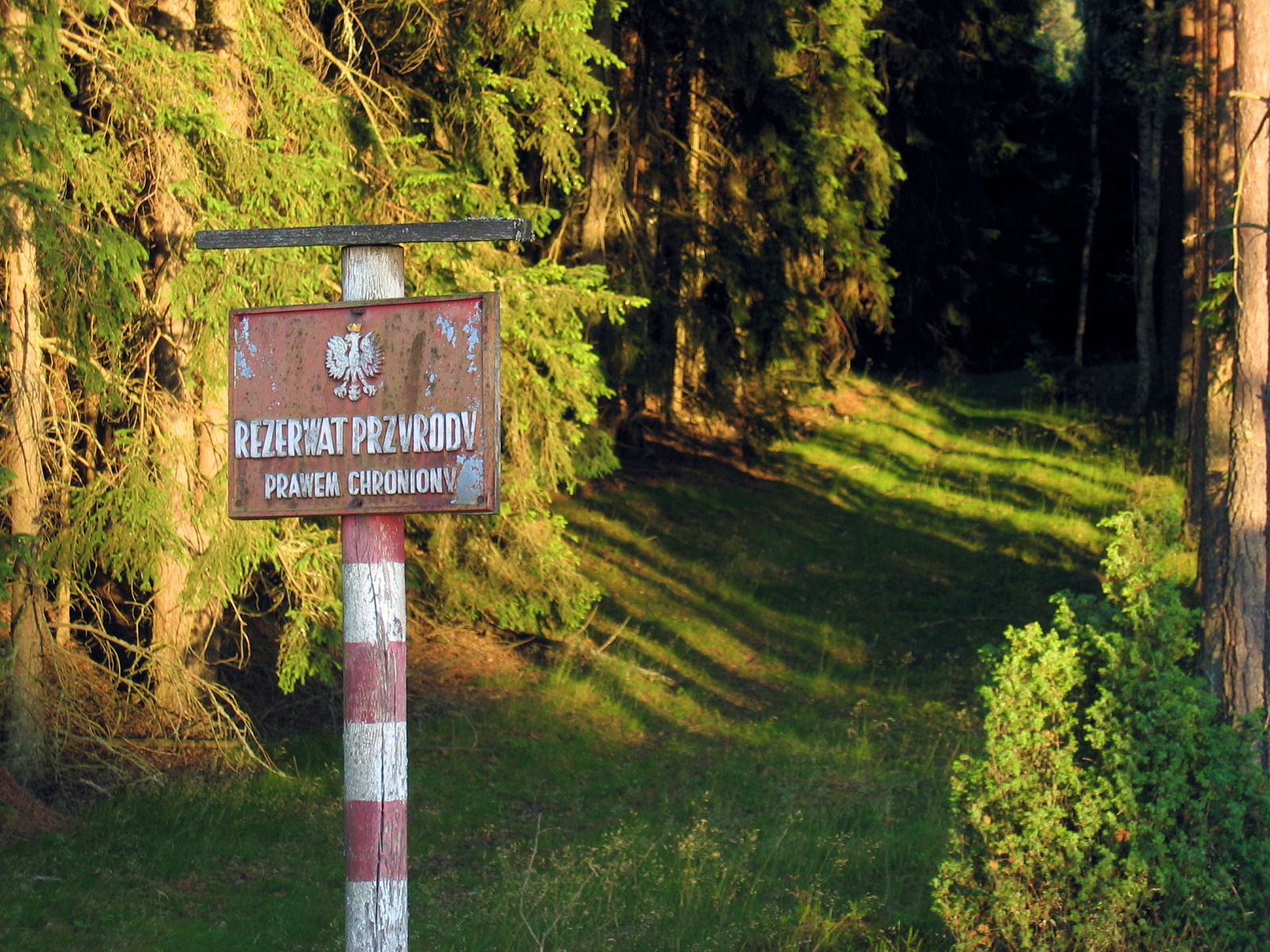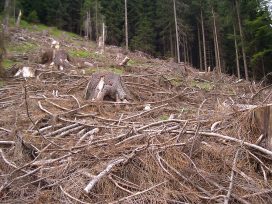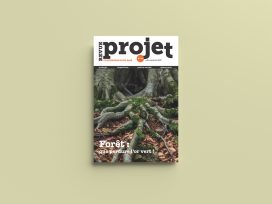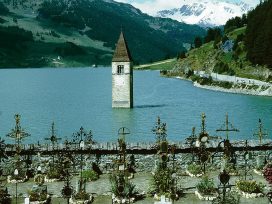One September afternoon, we leave the car safely parked and take the path to the top of the hill. It takes us nearly an hour to reach the place where the forest becomes a clearing. On its edge, a wooden fence surrounds the sparse remains of a forest lodge. A little further, its ruined foundations are similarly marked. Jadwiga, my guide, urges me on. She takes me up a narrow path with a metal net along each side indicating the perimeter of cultivated woodland. Sapling conifers have been planted amid the tangle of fencing. Finally, we reach the monument Jadwiga wants me to see. A boulder has been placed between an ancient, broad branched chestnut and a calcified sycamore, next to a large wooden cross. It has a plaque which reads: ‘In memory of 74 Poles, bestially slaughtered by Ukrainian nationalists. In this place there once stood a forest lodge. Polish foresters from the Upper San Valley sought refuge for their families here, as they tried to escape the terror of the Ukrainian Insurgent Army. All, including forester Franciszek Krol and his family, were killed in August 1944. Hail to their memory! The foresters of the Bieszczady region, November 2009.’ On the boulder, red and white ribbons flutter in the wind.

Bory Tucholskie – Tuchola Forests, Poland. Source: Flickr
Twelve oak trees
October. It has just stopped raining. The wind is cold and, as I press the trigger of the camera, my fingers freeze. A few days ago, on 12 October 2013, the forester’s chaplain blessed a new obelisk outside the entrance of the Leon Wyczolkowski ‘Old Polish Yews’ Nature Reserve in Wierzchlas – the oldest reserve in Poland and the second oldest in Europe. A monument has been erected there by the Regional Directorate of National Forests and local forest management. The inscription reads: ‘All hail and glory to the Foresters of the Republic of Poland, victims of the Katyn Massacre, a monstrous crime committed by the Soviet Union in April and May 1944. The Katyn Forest – Smolensk – Kharkov – Tver – Bykivnia – Kurapaty and other places in this “inhuman land”. If we forget them, may you, oh Lord, forget us… The Foresters of Kujawy and Pomorze, October 2013.’ The monument is a carved and polished granite pillar with an image of Our Lady of Katyn. At the base of the column is a small plaque reading: ‘Land sanctified by Polish blood. The Katyn Forest, Kharkov, Miednoye, Bykivnia, Kurapaty’.
Beside the memorial stands a large cross. A little further away information boards have been put up about the Katyn massacre and the foresters murdered there. The road to the monument passes through an alley of twelve equidistantly planted young oaks surrounded by metal nets. They are Memory Oaks. Each one has a plaque bearing the name of a forester who worked for the Regional Directorate of National Forests in Torun before the war and was later killed by the Soviets.
Trees aren’t just supposed to grow. They are expected to teach you what to remember. They help create a history that can be repeatedly played out and re-invoked. Their account of the past becomes the foundation for forest ‘mytho-praxis’, to borrow the term coined by the anthropologist Marshall Sahlins.
When cultivating nature becomes managing memory
These are just two of the many ‘memory groves’ I visited while researching the anthropology of the Polish forest. Sometimes it would be just a single tree, planted ceremonially in one way or another: the Oak of John Paul II, grown from acorns blessed by the Polish pope, for example, or the Oak of Freedom planted to commemorate the twenty-fifth anniversary of the introduction of democracy. At other times it would be ‘memory trees’ dedicated to foresters who had died for their country, or simply trees that had been grown close to monuments commemorating particular historical events. These sites – which I call ‘memory groves’ or ‘sacred groves’ – are where Polish foresters marshal memory and symbolic systems to re-enact the national myth and link it to what they do. Places like mentioned above (non-existent) Brenzberg forest lodge, or the alley of oak trees in the Leon Wyczolkowski ‘Old Polish Yews’ Nature Reserve in Wierzchlas, give foresters the opportunity not only to narrate the national myth, but to portray it in the here and now. ‘Memory groves’ link past and present through the process of remembering. This kind of connection can transform woodland into surrogate history. And where a forest has become history, cultivating nature is also a way of managing memory.
The woodland myth
The national woodland myth links the destiny of the country with the history of wooded areas and indigenous forestry. The Polish narrative becomes the story of the forest and vice versa. It is connected to the belief that Poland cannot exist without its woods, just as it cannot exist without its native foresters. Equally, it is based on the assumption that forests and forestry cannot exist without Poland – the country, the nation, the fatherland. The heroes of the myth are foresters. They feature as leaders, defenders of the fatherland and the nation’s finest sons, especially at times such as war, partition or uprisings. Their deeds offer an explanation for where we are today and serve as a model for the present generation.
In 1991, a law on forests was passed. Over 80 per cent of woodland territory remained in the hands of the state administration following the political transition (forest land was partially nationalized in 1944). In 1991, about 78 per cent of this woodland fell under the administration of the ‘State Forests’ National Forest Holding, meaning that it now manages nearly a third of the territory of the country. According to the narrative of Polish foresters since 1991, two irreducible principles underlie the preservation of the ‘harmonious order’: first, the forest is part of the national heritage; second, Polish foresters must be perceived as guardians of that heritage.
In March 2015, a forester in the Bieszczady region challenged me with the following question: ‘Have you ever seen the fatherland? Or the nation? Or religion? I haven’t. Yet so many have died for these things’ – as if to suggest, not a little subversively, that the real fatherland is the forest itself. Thanks to the efforts of contemporary foresters, users of the woodland space have been able to discover a fatherland and a nation in the Polish forest. But for this to be possible, the forest had to become a place where the national myth could be played out, through activities such as building, protecting the environment, or maintaining ‘memory groves’. Public events and ceremonies organised around them also contribute, with foresters (past and present) featuring in starring roles. For the forest to become a surrogate nation, a specific process has to take place: the forest’s past must become history, history must become heritage, and heritage must begin to function as a surrogate for the nation.
Foresters and forest mytho-praxis
A forest doesn’t become ‘a nation’ of its own accord. Foresters have to make this happen. Managing memory isn’t just about the creation of discourse, but about what will make the past re-occur in the present. History doesn’t need to be narrated. It can be presented in other ways. What foresters do is not so much a retelling of the national myth but its continuous re-creation. Life is lived with myth and through myth.
This is evident not just because a monument has been placed beside the site of a former? forest lodge, for example, but also through the way foresters contribute to ceremonies taking place in the area, or the way selected natural objects are enclosed by wooden fences. Discourse is a powerful means, but not always sufficiently tangible. Deeds that make narratives a visible reality are crucial. History, based on national myth, becomes a way of experiencing the past in a way that embraces the experience of the present. It is a continuous re-alignment and re-creation of the world in which we live.
Marshall Sahlins coined the term ‘mytho-praxis’ to explain the conduct of the Maori during wars with the British in the nineteenth century. As Sahlins defines it, mytho-praxis is a process of updating myth, which makes present events both comprehensible and sacred. Anything done at any particular time can be interpreted in the context of that symbolic structure. But mytho-praxis is not confined to the past or the present. Even though ‘the final form of the cosmic myth is the current event’, the myth is flexible enough to undergo transformation. Consequently, it can serve as a potential framework for the future. In other words, myths provide a matrix for social actors. They have license to function within it, but the interpretation of the myth is conditioned by the concrete interests of the group.
The postulates Sahlins applies to interpret the behaviour of the Maori are also useful in analysing of the actions of Polish foresters. They too ‘find themselves in history’ and through it discover ways of explaining contemporary reality. They merge local historical events with the history of Poland, and with the history of forestry, to create a single, national woodland myth. Foresters apply established models to maintain a particular order or recreate one that has been lost. Their aim is to elevate the status of forestry in Polish society, and to preserve the current structure of ownership, and organisation of forestry. They present themselves as a group that has guarded and preserved the national heritage for hundreds of years, maintaining and recreating the forest by their political position and their actions.
Without the constant recreation of this order by foresters, so the story goes, the entire system may collapse. If they no longer contribute, the structure of forest maintenance, and of the present as we know it, could be destroyed. To foresters, the woodland myth explains the world of the forest and keeps it intact. By the recreation of the national woodland myth – that is to say through anniversaries, monuments, memorial spaces, plaques, ceremonies, concerts, publications, educational nature trails – past generations of foresters (whose historical role makes them ‘other’) become identified with ‘us’ or the heroic ‘forest brotherhood’.
The mythical bond of kinship becomes fixed in the topography of the forest. The community may not be linked by blood bonds, but foresters are often united by the conviction that they spilt blood together for the forest. The group is bound by a history structured and written into the woodland environment. As Tim Ingold has written: ‘Just as kinship is geography, so the lives of persons and the histories of their relationships can be traced in the textures of the land.’ The mythical kinship of the forest brotherhood becomes manifest in the trees cared for by generations of foresters. The collective self, which includes previous generations, underpins the foresters’ conviction that tasks performed by previous generations of the ‘forest brotherhood’ are linked to what they do today and to the work that will be undertaken by future armies of foresters.
Trees as keepers of memory
The monument to the foresters of Kujawy and Pomorze who died in Katyn is beside the entrance to the Leon Wyczolkowski ‘Old Polish Yews’ Nature Reserve in Wierzchlas, central Poland. The park holds almost four thousand yew trees and represents what remains of the Pomeranian primeval forest. It is the biggest natural aggregation of this type of tree in Europe and exists thanks to the patronage and goodwill of the distinguished painter Leon Wyczolkowski, a frequent visitor to the area. I wonder why the Katyn memorial and the Memory Oaks have been placed here. The foresters explained it as follows: Wierzchlas is the symbolic centre of the Tuchola Pinewoods. It is often visited by tourists, so the monument will be seen. The intention was to combine the principle of ecological conservation, symbolised by the reserve, with a depiction of sacrifices that have had to be made in its name. The foresters explained that preservation of the natural environment remains their role. Those who died to protect it – such as the foresters murdered in Katyn – should continue to be remembered today.
It is my view that combining a narrative about environmental protection with a particular interpretation of Polish history has been the conscious work of foresters, as a group. The nature reserve in Wierzchlas and the monument to Polish foresters killed in Katyn complement and enhance one another. Their purpose is to tell the single story that is the national woodland myth. Remembrance is written into the nature reserve and the trees within it. The same is true of the non-existent forest lodge in Brenzberg. The memorial has been placed next to a chestnut and a sycamore that ‘remember’ the events of 1944. They alone ‘witnessed’ them. Saplings are now being grown beside the road to the monument. They are surrounded by metal barriers and cultivated by local foresters. What is left of the lodge also forms part of a historical nature trail, set up by the local forest management team. There too you can see nature and memory managed jointly and witness how the ‘remembering’ function of trees may be used in the service of forest mytho-praxis and a single, specific version of the national myth.
Deeper into the forest, further into history
‘Memory groves’ and the activities foresters have organised around them have an additional dimension. They transform woodland areas cultivated by foresters into spaces that act as surrogates for notions of Polish state territory, the nation and its history. The forest becomes synonymous with the fatherland and foresters present themselves as guardians of Polish tradition and culture. But if the national myth explains the past and orders the present, it also harbours intentions for the future. Which is why a vision of the forest as national heritage should not be divorced from what is done to conjure it up or from projects based upon it.
The vision underpinning the actions of Polish foresters has more than a symbolic meaning. It carries practical and material consequences. The national myth, and the historical narrative contained within it, can be thought of as a shared symbolic language. They provide a base that helps foresters act in a way they can all understand. Forest mytho-praxis is an expression of this language. It explains the world, consolidates the forestry community, and creates a space for further action. The way mytho-praxis functions was evident during the campaign to secure ‘Polish forests and land’, for example.
While undertaking ‘a defence of Polish forests’ to challenge proposals that woodland should be sold to foreign buyers, the environment minister Jan Szyszko said in 2015: ‘We are preparing a forest law, so that woodland should be protected by Polish legislation, in order that it should serve the Polish people, in order that that it should continue to guarantee the existence of the state and the Polish nation. A nation without land faces extinction.’ Similar conflations of forests, foresters, Polish territory and national security have led to the collection of over two million signatures in support of a proposed referendum on the preservation of the ‘State Forests’ industry in its current form. The Polish president Andrzej Duda successfully argued, during his election campaign, that ‘Polish forests must stay in Polish hands’.
The methods used by Polish foresters to manage the woodland environment also work to manipulate memory. If history is understood not just as a narrative about the past, but also as a way of building the world (‘world making’), it becomes plain that elements of the natural environment such as trees are frequently exploited to control and impose order on the present.









